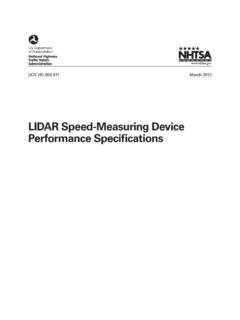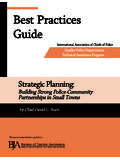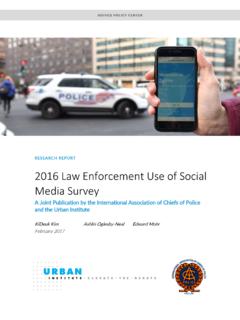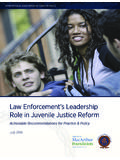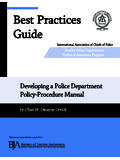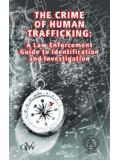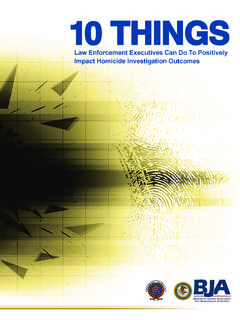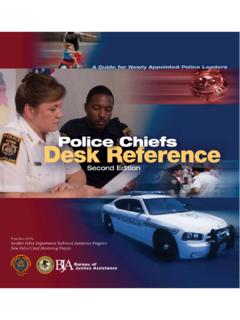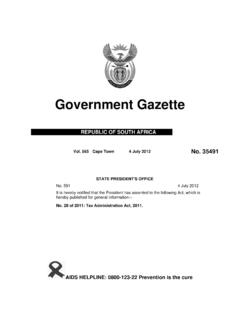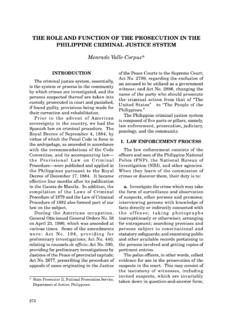Transcription of Presented by Bill Amato Captain Aaron Jones
1 Presented byBill AmatoCaptain Aaron Jones Acquaint participants with Brady/Giglio and their application to peace officer integrity Provide perspectives as the issues that surround Brady/Giglio Identify issues that may present themselves in the future Give guidance/examples to developing Brady/Giglio disclosure procedures for LE agencies Brady vMaryland, 373 83 (1963) United States v. Giglio, 405 150 (1972) v. Bagley, 473 667 (1985) Kylesv. Whitley, 514 419 (1995) Stricklerv. Green, 527 263 (1999) 1963 Capital Murder case Government had a duty to disclose material exculpatory evidence Failure to do so violated due process where the evidence is material to either guilty, innocence of the accused or punishment There is no regard for good or bad faith of the prosecutorUnder the Constitution, due process requires the prosecution to turn over evidence favorable to the accused and material to his guilt or punishment. This requirement includes evidence that may beused to impeach the prosecution s witnesses, including police officers and police agencies are, for purposes of Brady, considered to be part of the prosecution team.
2 They must therefore make the prosecutor aware of any evidence that may be favorable to the accused. Brady rule includes evidence that could be used to impeach a witness When the reliability of a given witness may be determinative of guilt or innocence, non-disclosure of evidence affecting credibility falls within the rule regardless of whether withheld in good faith No legal distinction between exculpatory evidence and impeachment evidence for purposes of Brady rule Favorable evidence is material if there is a reasonable probability that the result would have been different if defense had known harmless error standard does not apply issue is whether evidence is material Knowledge imputed to the prosecution includes knowledge that the police may have Prosecutor has a duty to learn of any favorable evidence known to others acting on behalf of the includes the policeExamples: Government s obligation to disclose favorable evidence under Brady covers not only material exculpatory evidence but also information that could impeach government witnesses Agreements exchanging testimony for money or favorable treatment The fact the witness suffers from hallucinations Efforts by one witness to improperly influence the testimony of other witnesses History of untruthfulness Other conflicting statements made by witnessesExamples: Prior inconsistent statements of key witnesses Government witnesses had previously filed a false report Information undermining the credibility of witness identification of defendant Doctor s report following an autopsy which conflicts with later trial testimonyDetective Jones is handling a rape investigation and develops information of a potential suspect who was seen leaving the scene in a white pick-up truck.
3 The investigator displays a photo line-up to the victim and she identifies the suspect, who does own a white pick-up. No forensic evidence connecting the suspect to the crime is initially discovered. During the course of the investigation, a witness is located during the area canvass who claims to have seen a beige pick-up truck in the area driven by a dark skinned male in his 30 s. The identified suspect is a light skinned male in his 20 s. The investigator does not document this information in his report because it contradicts the probable cause he has developed in his Smith is handling a murder investigation. He develops a suspect who is of limited intelligence and brings him to the station for questioning. After questioninghim over a period of days, he informs the suspect that if he confesses, he will be allowed to go home. The suspect confesses and is taken into custody and charged with murder. Detective Smith fails to document his promise of allowing the suspect to go home in exchange for confessing, and does not inform the White is handling a robbery investigation in which a victim is shot.
4 He discovers a footprint near the scene, which he has photographed and lifted. He subsequently arrests a suspect who is wearing a size 9 shoe. The foot print is a size 11 sneaker and Detective White discards the footprint evidence believing it is unrelated to the crime. He fails to document this Evans displays photo line-ups to three witnesses. Two of the witnesses identify a suspect; however, the third witness fails to identify anybody. Detective Evans documents the two positive identifications but does not document that the third witness failed to identify the suspect and Detective Evans never informs the prosecutor. Officer investigated, but no finding of violation I/A finding that officer had violated policy not relevant or unrelated to truthfulness I/A finding that officer made a false or misleading report or statement I/A finding that officer had violated policy touching on relevant trait or trial issue I/A finding that officer covered up or attempted to cover upThe three essential components of a Brady claim are: Evidence favorable to the defendant because it is exculpatory or impeaching; The state willfully or inadvertently suppressed the evidence; and Prejudice resulted Question does Bradymean we have to disclose evidence that does not show the defendant to be innocent, but mere casts doubt on the testimony of the prosecuting witness ?
5 YES!The term untruthfulness refers to false statements, falsereports, or intentionally incomplete statements and reports. The false statements involve all aspects of the job, not just enforcement and criminal investigations. See Dreary v. Gloucester, 9 191 (1st Cir. 1993) (Ten-year-old disciplinary finding that an officer falsified overtime records admitted for impeachment purposes); United States v. Williams, 1997 WL 335794 ( 1997) (New trial ordered because FBI failed to disclose that an agent who was a witness at trial had, fifteen years earlier, received a letter of reprimand for forging an informant s signature on a receipt and lying about the forgery under oath). Bias includes prior records allegedly showing anofficer s bias against an identifiable group, , African-Americans or gays. Bias could also be shown toward a particular person or family, based upon prior conduct or statements. Crimes committed by officers which must be disclosed include any crimes other than motor vehicle misdemeanors, DV, or DUI.
6 Even motor vehicle offenses must be disclosed to the prosecutor when the criminal case involves similar conduct. The belief that Internal Affairs files are confidential and not subject to closure is mistaken The adage that the defendant is on trial, not the officer, has been substantially eroded In certain circumstances, the officer s prior conduct is relevant in the criminal trial because that conduct reflects on the officer s credibilityDisclosure will assure the integrity of a criminal conviction. The general rule is that unverified or speculative information is not subject to disclosure. However, the decision to disclose such information is best left to the prosecutor. Misconduct involving moral turpitude, untruthfulness Bias Moral turpitude Integrity Misdemeanor convictions involving moral turpitude Contrary statements about facts of the case Evidence undermining the officer s Expertise False reports by the Officer in other cases Evidence of drug or alcohol addition *Bradyinformation must be disclosed to the prosecutor.
7 The prosecutor must then decide whether to disclose the information to the defense. It is very possible, however, that the information may not be admissible in court. Only that evidence which the court finds to be relevant for impeachment purposescan be used. The Department (Officers) should make sure the prosecutor is aware of any information about the officer that, if revealed, would be favorable to the defense. The Department (Officers) must disclose to the prosecutor anything in the officer s background that reflects bias, untruthfulness or criminal activity. The responsibility to disclose the information belongs to the prosecutor; let them make the decision. You do not want the agency/officer to be held responsible for the retrial of a case due to non-disclosure to the prosecutor. All of this applies to both felony and misdemeanor Obtain Review Disclose Argue Early Warning Systems EWS Supervisor notes E-mails Inter-office communications or memorandums Annual employee reviews Judicial report What is the Brady List ?
8 How does an officer get on the list? What does being on the list actually mean? Can an officer ever get off of the list?A Giglioor Brady list is a list compiled usually by a prosecutor's office or a police department containing the names and details of law enforcement officers who have had sustained incidents of untruthfulness, criminal convictions, candor issues, or some other type of issue placing their credibility into question. Police Department/Agencies must disclose information regarding potential Brady/Gigliomaterial to prosecutors Prosecutors will then review the information to determine what actions will be taken next Both the law enforcement agency and the prosecutor s office should maintain the list of disclosures Prosecutors will then review the disclosures and make case by case determinations as to how to handle the information The following is not about exculpatory evidence Referring to acts/incidents involving law enforcement officers that could call their credibility into question.
9 Not just acts of dishonesty. Any criminal record of any witness , or any criminal case pending against any witness , whom the prosecution anticipates calling. Information, known to the Department, that casts doubt on the credibility or accuracy of a witness or evidence. Information, known to the Department, regarding any mental or physical impairment of any governmental witness that would cast doubt on his or her ability to testify accurately and truthfully at trial. A finding of misconduct by the Civil Service Commission or a completed internal investigation that reflects on an officer or other member of this Department's truthfulness, bias, or moral turpitude. This includes employees under suspension. Evidence that a proposed witness has a racial, religious, or personal bias against a defendant individually or as a member of a group. Other information which may be considered as appropriately disclosableBrady material reflecting upon an officer s truthfulness, honesty, bias or misconduct includes, but is not limited to, the following developed from relevant case law:(i) lying to superiors during internal/administrative police investigations;(ii) falsifying police reports or making misleading reports;(iii) planting evidence;(iv) theft of evidence in police custody;(v) failed polygraphs;(vi) inappropriate records checks of detainees or witnesses.
10 (vii) any history of lying in the process of testifying or preparing affidavits under oath Established a review committee for Brady/ Gigliodisclosures Placement on the Brady List is not automatic after a disclosure from LE All LE disclosures (called referrals) are vetted through a committee made up of criminal Chief Prosecutors and LE Liaison Officers are placed on the Brady List after a preponderance of the evidence finding that the referral is Brady/Giglio material Once a finding is made, the officer is sent a letter describing the committee s finding Will review future administrative findings to determine if placement on the list is still warranted Modeled closely to what the Hamilton CountyProsecutors requested Went through the Cincinnati Police DepartmentManual or Rules and Regulations and matched specific rule violations with Brady/Gigliorequested information Created a SOP whereas specific violations were deemed mandatory disclosures Other violations can trigger disclosure, but more investigation is warranted A database was created where specific violationsautomatically required additional tasks to close theinvestigation.

